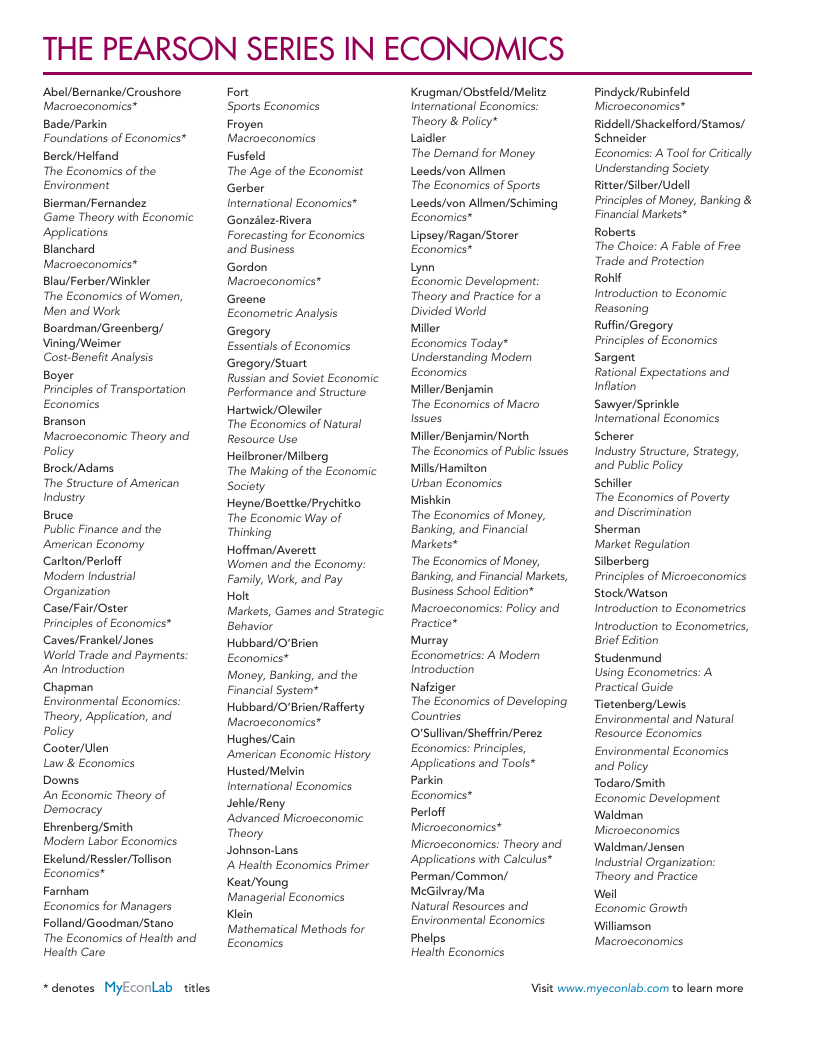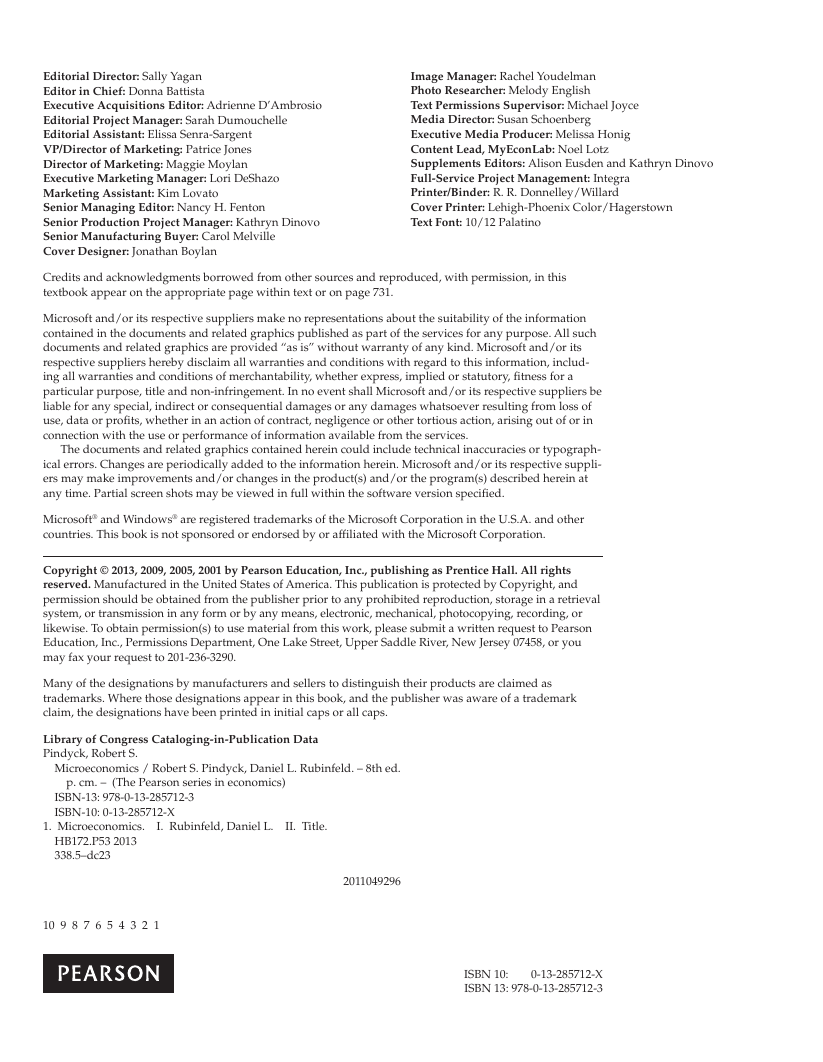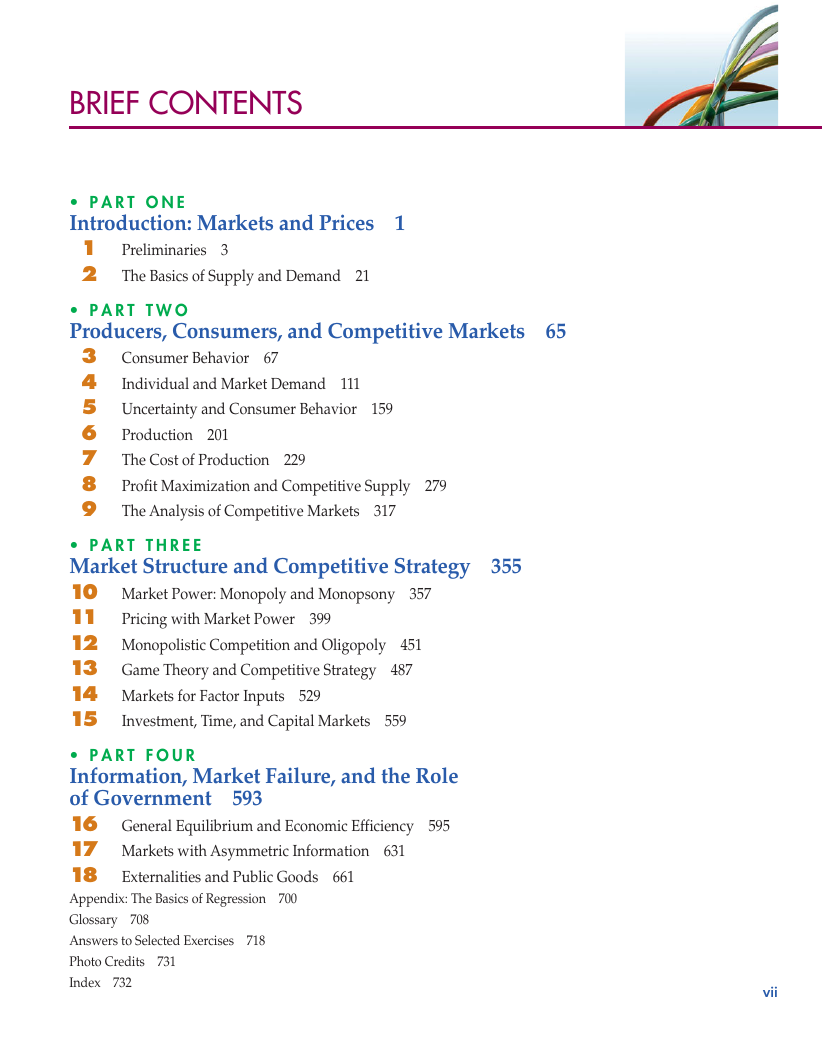Cover
Contents
Preface
PART ONE: Introduction: Markets and Prices
1 Preliminaries
1.1 The Themes of Microeconomics
1.2 What Is a Market?
1.3 Real versus Nominal Prices
1.4 Why Study Microeconomics?
Summary
Questions for Review
Exercises
2 The Basics of Supply and Demand
2.1 Supply and Demand
2.2 The Market Mechanism
2.3 Changes in Market Equilibrium
2.4 Elasticities of Supply and Demand
2.5 Short-Run versus Long-Run Elasticities
*2.6 Understanding and Predicting the Effects of Changing Market Conditions
2.7 Effects of Government Intervention—Price Controls
Summary
Questions for Review
Exercises
PART TWO: Producers, Consumers, and Competitive Markets
3 Consumer Behavior
3.1 Consumer Preferences
3.2 Budget Constraints
3.3 Consumer Choice
3.4 Revealed Preference
3.5 Marginal Utility and Consumer Choice
*3.6 Cost-of-Living Indexes
Summary
Questions for Review
Exercises
4 Individual and Market Demand
4.1 Individual Demand
4.2 Income and Substitution Effects
4.3 Market Demand
4.4 Consumer Surplus
4.5 Network Externalities
*4.6 Empirical Estimation of Demand
Summary
Questions for Review
Exercises
APPENDIX TO CHAPTER 4: Demand Theory—A Mathematical Treatment
Utility Maximization
The Method of Lagrange Multipliers
The Equal Marginal Principle
Marginal Rate of Substitution
Marginal Utility of Income
An Example
Duality in Consumer Theory
Income and Substitution Effects
Exercises
5 Uncertainty and Consumer Behavior
5.1 Describing Risk
5.2 Preferences Toward Risk
5.3 Reducing Risk
*5.4 The Demand for Risky Assets
5.5 Bubbles
5.6 Behavioral Economics
Summary
Questions for Review
Exercises
6 Production
6.1 Firms and Their Production Decisions
6.2 Production with One Variable Input (Labor)
6.3 Production with Two Variable Inputs
6.4 Returns to Scale
Summary
Questions for Review
Exercises
7 The Cost of Production
7.1 Measuring Cost: Which Costs Matter?
7.2 Cost in the Short Run
7.3 Cost in the Long Run
7.4 Long-Run versus Short-Run Cost Curves
7.5 Production with Two Outputs—Economies of Scope
*7.6 Dynamic Changes in Costs—The Learning Curve
7.7 Estimating and Predicting Cost
Summary
Questions for Review
Exercises
APPENDIX TO CHAPTER 7: Production and Cost Theory—A Mathematical Treatment
Cost Minimization
Marginal Rate of Technical Substitution
Duality in Production and Cost Theory
The Cobb-Douglas Cost and Production Functions
Exercises
8 Profit Maximization and Competitive Supply
8.1 Perfectly Competitive Markets
8.2 Profit Maximization
8.3 Marginal Revenue, Marginal Cost, and Profit Maximization
8.4 Choosing Output in the Short Run
8.5 The Competitive Firm’s Short-Run Supply Curve
8.6 The Short-Run Market Supply Curve
8.7 Choosing Output in the Long Run
8.8 The Industry’s Long-Run Supply Curve
Summary
Questions for Review
Exercises
9 The Analysis of Competitive Markets
9.1 Evaluating the Gains and Losses from Government Policies—Consumer and Producer Surplus
9.2 The Efficiency of a Competitive Market
9.3 Minimum Prices
9.4 Price Supports and Production Quotas
9.5 Import Quotas and Tariffs
9.6 The Impact of a Tax or Subsidy
Summary
Questions for Review
Exercises
PART THREE: Market Structure and Competitive Strategy
10 Market Power: Monopoly and Monopsony
10.1 Monopoly
10.2 Monopoly Power
10.3 Sources of Monopoly Power
10.4 The Social Costs of Monopoly Power
10.5 Monopsony
10.6 Monopsony Power
10.7 Limiting Market Power: The Antitrust Laws
Summary
Questions for Review
Exercises
11 Pricing with Market Power
11.1 Capturing Consumer Surplus
11.2 Price Discrimination
11.3 Intertemporal Price Discrimination and Peak-Load Pricing
11.4 The Two-Part Tariff
*11.5 Bundling
*11.6 Advertising
Summary
Questions for Review
Exercises
APPENDIX TO CHAPTER 11: The Vertically Integrated Firm
Why Vertically Integrate?
Transfer Pricing in the Integrated Firm
A Numerical Example
Exercises
12 Monopolistic Competition and Oligopoly
12.1 Monopolistic Competition
12.2 Oligopoly
12.3 Price Competition
12.4 Competition versus Collusion: The Prisoners’ Dilemma
12.5 Implications of the Prisoners’ Dilemma for Oligopolistic Pricing
12.6 Cartels
Summary
Questions for Review
Exercises
13 Game Theory and Competitive Strategy
13.1 Gaming and Strategic Decisions
13.2 Dominant Strategies
13.3 The Nash Equilibrium Revisited
13.4 Repeated Games
13.5 Sequential Games
13.6 Threats, Commitments, and Credibility
13.7 Entry Deterrence
*13.8 Auctions
Summary
Questions for Review
Exercises
14 Markets for Factor Inputs
14.1 Competitive Factor Markets
14.2 Equilibrium in a Competitive Factor Market
14.3 Factor Markets with Monopsony Power
14.4 Factor Markets with Monopoly Power
Summary
Questions for Review
Exercises
15 Investment, Time, and Capital Markets
15.1 Stocks versus Flows
15.2 Present Discounted Value
15.3 The Value of a Bond
15.4 The Net Present Value Criterion for Capital Investment Decisions
15.5 Adjustments for Risk
15.6 Investment Decisions by Consumers
15.7 Investments in Human Capital
*15.8 Intertemporal Production Decisions—Depletable Resources
15.9 How Are Interest Rates Determined?
Summary
Questions for Review
Exercises
PART FOUR: Information, Market Failure, and the Role of Government
16 General Equilibrium and Economic Efficiency
16.1 General Equilibrium Analysis
16.2 Efficiency in Exchange
16.3 Equity and Efficiency
16.4 Efficiency in Production
16.5 The Gains from Free Trade
16.6 An Overview—The Efficiency of Competitive Markets
16.7 Why Markets Fail
Summary
Questions for Review
Exercises
17 Markets with Asymmetric Information
17.1 Quality Uncertainty and the Market for Lemons
17.2 Market Signaling
17.3 Moral Hazard
17.4 The Principal–Agent Problem
*17.5 Managerial Incentives in an Integrated Firm
17.6 Asymmetric Information in Labor Markets: Efficiency Wage Theory
Summary
Questions for Review
Exercises
18 Externalities and Public Goods
18.1 Externalities
18.2 Ways of Correcting Market Failure
18.3 Stock Externalities
18.4 Externalities and Property Rights
18.5 Common Property Resources
18.6 Public Goods
18.7 Private Preferences for Public Goods
Summary
Questions for Review
Exercises
APPENDIX: The Basics of Regression
An Example
Estimation
Statistical Tests
Goodness of Fit
Economic Forecasting
Summary
Glossary
A
B
C
D
E
F
G
H
I
K
L
M
N
O
P
Q
R
S
T
U
V
W
Z
Answers to Selected Exercises
Photo Credits
Index
A
B
C
D
E
F
G
H
I
J
K
L
M
N
O
P
Q
R
S
T
U
V
W
X
Y
Z
















 2023年江西萍乡中考道德与法治真题及答案.doc
2023年江西萍乡中考道德与法治真题及答案.doc 2012年重庆南川中考生物真题及答案.doc
2012年重庆南川中考生物真题及答案.doc 2013年江西师范大学地理学综合及文艺理论基础考研真题.doc
2013年江西师范大学地理学综合及文艺理论基础考研真题.doc 2020年四川甘孜小升初语文真题及答案I卷.doc
2020年四川甘孜小升初语文真题及答案I卷.doc 2020年注册岩土工程师专业基础考试真题及答案.doc
2020年注册岩土工程师专业基础考试真题及答案.doc 2023-2024学年福建省厦门市九年级上学期数学月考试题及答案.doc
2023-2024学年福建省厦门市九年级上学期数学月考试题及答案.doc 2021-2022学年辽宁省沈阳市大东区九年级上学期语文期末试题及答案.doc
2021-2022学年辽宁省沈阳市大东区九年级上学期语文期末试题及答案.doc 2022-2023学年北京东城区初三第一学期物理期末试卷及答案.doc
2022-2023学年北京东城区初三第一学期物理期末试卷及答案.doc 2018上半年江西教师资格初中地理学科知识与教学能力真题及答案.doc
2018上半年江西教师资格初中地理学科知识与教学能力真题及答案.doc 2012年河北国家公务员申论考试真题及答案-省级.doc
2012年河北国家公务员申论考试真题及答案-省级.doc 2020-2021学年江苏省扬州市江都区邵樊片九年级上学期数学第一次质量检测试题及答案.doc
2020-2021学年江苏省扬州市江都区邵樊片九年级上学期数学第一次质量检测试题及答案.doc 2022下半年黑龙江教师资格证中学综合素质真题及答案.doc
2022下半年黑龙江教师资格证中学综合素质真题及答案.doc